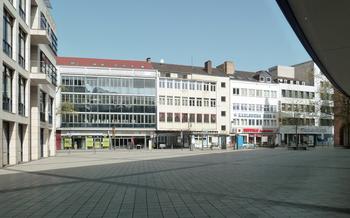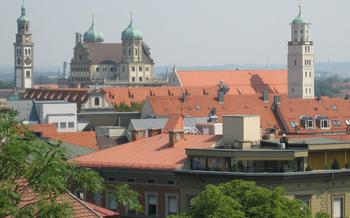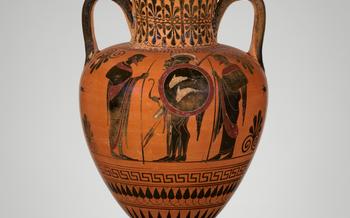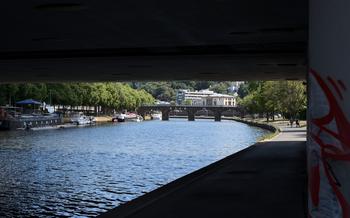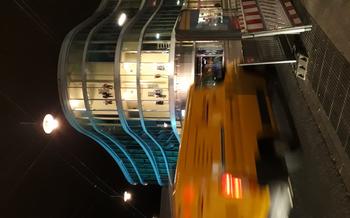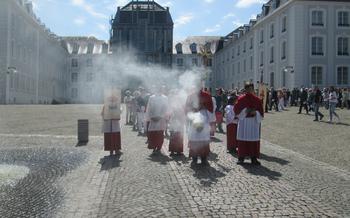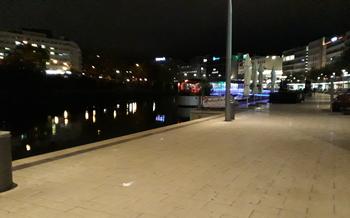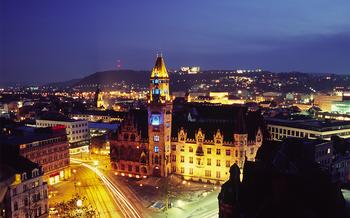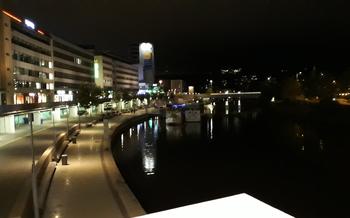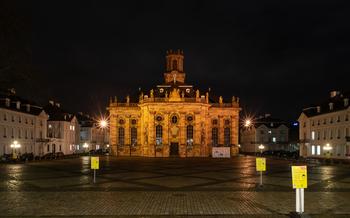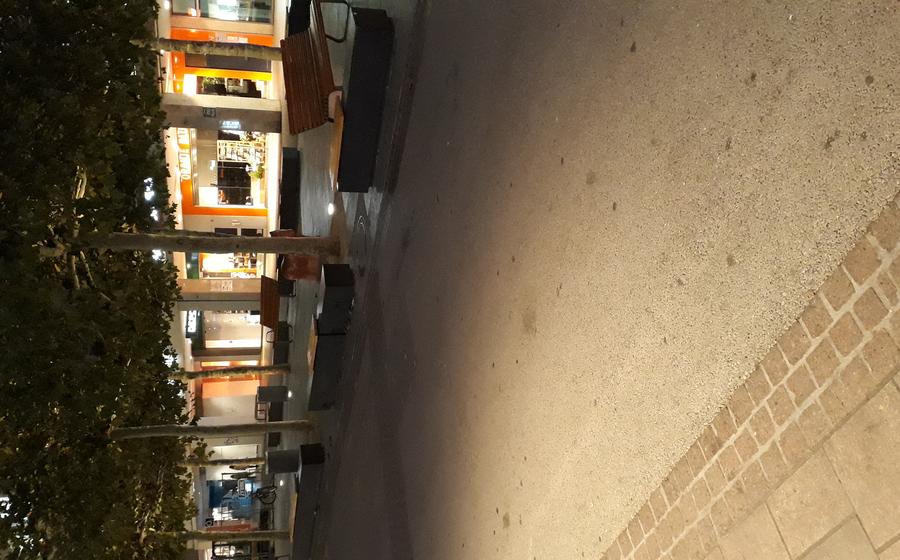
Historical Museum Saar
- A Journey Through History
- The Roman Legacy
- Medieval Marvels
- The Industrial Revolution's Impact: A Legacy of Innovation and Transformation
- World War II and Beyond
- Interactive Experiences
- Special Exhibitions
- Educational Programs
- Research and Scholarship
- Community Engagement
- Architectural Significance
- Museum Shop and Cafeteria: Enhancing the Visitor Experience
- Accessibility and Inclusivity
- Planning Your Visit
- Insider Tip: Uncover the Secret Roman Garden
A Journey Through History
The Historical Museum Saar, a treasure trove of Saarbrücken's rich past, invites you on an enthralling journey through time. Nestled in the heart of the city, the museum is easily accessible by foot, public transportation, or car. Its doors are open Tuesday through Sunday, from 10 am to 6 pm, with extended hours on Thursdays until 8 pm. Admission fees are reasonable, with concessions for students, seniors, and families. Guided tours are available upon request, offering a personalized and immersive experience.
Within the museum's walls, a world of historical wonders awaits. The gift shop entices with an array of souvenirs, books, and historical artifacts, while the on-site cafeteria provides a welcoming space for visitors to relax and reflect amidst the echoes of the past.
The Roman Legacy
Saarbrücken's rich Roman history dates back to the 1st century BC when the Romans established a military camp in the area. The city's strategic location on the Saar River made it an important trade and military center. Numerous Roman artifacts and exhibits within the Historical Museum Saar attest to the region's Roman heritage.
One of the highlights of the museum's Roman collection is a beautifully preserved Roman mosaic depicting scenes from Roman mythology. The mosaic, discovered in a nearby villa, offers a glimpse into the artistic and cultural traditions of the Roman Empire. Other notable exhibits include Roman coins, pottery, jewelry, and tools, providing insights into everyday life during the Roman period.
Interactive displays and multimedia presentations further enhance the museum's exploration of Roman culture. Visitors can virtually tour a Roman villa, learn about Roman construction techniques, and even try their hand at writing on a wax tablet. Through these interactive experiences, the museum brings the Roman era to life and makes it accessible to visitors of all ages.
Historical context and background information are provided throughout the museum to help visitors understand the significance of the Roman legacy in Saarbrücken. Detailed descriptions, maps, and timelines explain the Roman Empire's rise and fall, as well as its impact on the region's history and culture. By immersing themselves in the museum's Roman collection, visitors gain a deeper appreciation for the enduring influence of the Roman Empire on Saarbrücken and the surrounding area.
Medieval Marvels
The medieval era left an indelible mark on Saarbrücken, and the Historical Museum Saar showcases this rich heritage through a captivating collection of artifacts, interactive displays, and multimedia presentations. Step into the world of knights, castles, and craftsmanship as you explore the museum's medieval galleries.
Admire intricate suits of armor, gleaming swords, and beautifully preserved tapestries that tell tales of chivalry, battles, and courtly life. Discover the secrets of medieval craftsmanship through exhibits showcasing pottery, woodworking, and metalworking techniques passed down through generations.
Walk through virtual recreations of medieval towns and castles, and immerse yourself in the sights and sounds of the period. Interactive displays allow you to handle replicas of medieval tools and objects, providing a hands-on experience of daily life in the Middle Ages.
Historical context and background information accompany each exhibit, enriching your understanding of the social, cultural, and political forces that shaped medieval Saarbrücken. Learn about the rise and fall of feudalism, the impact of the Crusades, and the influence of the Church on everyday life.
The Medieval Marvels section of the Historical Museum Saar offers a comprehensive and engaging journey through a fascinating period of Saarbrücken's history. Whether you're a history buff, a lover of medieval culture, or simply curious about the past, this section promises an immersive and unforgettable experience.
The Industrial Revolution's Impact: A Legacy of Innovation and Transformation
During the 19th century, Saarbrücken emerged as a prominent industrial hub, playing a pivotal role in the region's economic development. The Historical Museum Saar vividly captures this era of transformation, showcasing a diverse array of artifacts, exhibits, and interactive displays that illuminate the region's industrial heritage.
Visitors can marvel at the intricate machinery, tools, and products that shaped Saarbrücken's industrial landscape. Steam engines, mining equipment, and manufacturing machinery stand as testaments to the ingenuity and craftsmanship of the region's engineers and workers. Interactive displays and multimedia presentations bring the industrial processes to life, allowing visitors to experience the sights, sounds, and smells of a bygone era.
Through historical context and background information, the museum provides a deeper understanding of the social, economic, and political factors that fueled Saarbrücken's industrial growth. Visitors learn about the challenges and opportunities faced by workers, the rise of labor movements, and the impact of industrialization on the region's environment and society.
This chapter of the museum's journey offers a fascinating glimpse into Saarbrücken's transformation from a sleepy town to a bustling industrial center. It is a testament to the region's resilience, innovation, and the enduring legacy of the Industrial Revolution.
World War II and Beyond
The scars of World War II run deep in Saarbrücken, and the Historical Museum Saar offers a poignant glimpse into this turbulent period. Exhibits showcase the wartime experiences of the city's residents, from the fear and uncertainty of air raids to the devastation wrought by Allied bombings. Personal accounts, artifacts, and documents paint a vivid picture of life during this tumultuous time. Interactive displays and multimedia presentations shed light on the consequences of war, exploring the human cost and the long-lasting impact on the region. The museum also delves into the post-war era, examining Saarbrücken's reconstruction and its emergence as a symbol of resilience and hope.
Interactive Experiences
The Historical Museum Saar employs interactive displays and multimedia presentations to captivate visitors and make history come alive. Interactive touchscreens, virtual reality headsets, and augmented reality experiences allow visitors to explore historical artifacts and scenes in immersive and engaging ways. Hands-on activities and workshops for children and families further enhance the learning experience, encouraging them to participate actively and discover history through play. Sensory installations, such as replicas of historical objects that visitors can touch and feel, add another dimension to the museum experience, creating a deeper connection to the past. These interactive elements not only educate and entertain but also foster a sense of curiosity and wonder, leaving a lasting impression on visitors of all ages.
Special Exhibitions
The Historical Museum Saar presents a dynamic program of temporary exhibitions, offering visitors a fresh perspective on various historical topics. These exhibitions showcase unique artifacts, perspectives, and collaborations with other museums and institutions. Thematic exhibitions explore specific periods or aspects of Saarbrücken's history, providing visitors with an in-depth understanding of the city's rich past. Limited-time exhibits encourage repeat visits, ensuring that there is always something new to discover at the museum.
Educational Programs
The Historical Museum Saar is dedicated to providing educational opportunities and resources to the community. It offers a range of programs designed to engage and educate visitors of all ages.
Guided tours are available for groups of all sizes and can be tailored to specific interests and age groups. These tours provide an in-depth exploration of the museum's collections and exhibitions, led by knowledgeable and experienced museum guides.
Workshops, lectures, and seminars are also organized on a regular basis, covering a wide range of historical topics. These programs provide opportunities for visitors to delve deeper into specific aspects of history, interact with experts in the field, and engage in thought-provoking discussions.
Additionally, the museum offers educational resources and materials for teachers and researchers. This includes access to the museum's archives, library, and collections, as well as a variety of educational materials that can be used in the classroom or for personal research.
Through these educational programs and resources, the Historical Museum Saar strives to promote historical awareness, foster a love of learning, and inspire future generations of historians and researchers.
Research and Scholarship
The Historical Museum Saar is not only a repository of historical artifacts and exhibits but also a vital center for historical research and scholarship. The museum collaborates closely with universities and research institutions to advance knowledge and understanding of the region's past. Researchers have access to the museum's extensive archives, library, and collections, which house a wealth of primary sources, documents, and artifacts. The museum also organizes publications, conferences, and symposia to disseminate research findings and foster scholarly exchange. Through these initiatives, the Historical Museum Saar contributes to the advancement of historical knowledge and promotes a deeper understanding of Saarbrücken's rich and multifaceted past.
Community Engagement
The Historical Museum Saar recognizes the importance of engaging with the local community and fostering a sense of historical awareness among its citizens. To achieve this, the museum collaborates with various schools, community groups, and cultural organizations to organize public events, festivals, and celebrations that showcase the museum's collections and programs.
These events provide a platform for the museum to share its knowledge and expertise with the community, while also creating opportunities for dialogue and exchange. The museum also offers volunteer opportunities for individuals who are passionate about history and want to contribute to its preservation and promotion.
Through these initiatives, the Historical Museum Saar plays a vital role in connecting with the community, promoting historical awareness, and creating a sense of shared ownership and pride in the region's rich cultural heritage.
Architectural Significance
The Historical Museum Saar is housed in a magnificent historical building that is as captivating as the collections it holds within. The building itself is a testament to the city's rich history and architectural heritage. Constructed in the late 19th century, the building originally served as the headquarters of the Saarbrücken Chamber of Commerce. Its grand neo-Renaissance façade, adorned with intricate carvings and sculptures, reflects the architectural style prevalent during that era.
Over the years, the building underwent several renovations and expansions to accommodate the growing museum's needs. However, careful attention was paid to preserve its original character and architectural features. The building's elegant interiors feature high ceilings, ornate cornices, and marble staircases, creating a sense of grandeur and historical significance.
The Historical Museum Saar's building is not just a container for its collections but an integral part of the museum experience. It provides a fitting backdrop for the museum's exhibits, enhancing the visitor's appreciation of Saarbrücken's rich history and culture.
Museum Shop and Cafeteria: Enhancing the Visitor Experience
The Historical Museum Saar offers visitors the convenience of a well-stocked museum shop and an on-site cafeteria, enhancing the overall museum experience. The shop provides a range of souvenirs, books, and historical artifacts related to the museum's collections, allowing visitors to take a piece of history home with them. From postcards and magnets to replicas of Roman coins and medieval pottery, there's something for everyone.
The cafeteria offers a welcome respite for visitors to relax and reflect on their museum experience. The menu features a selection of refreshments, including hot and cold beverages, sandwiches, and snacks, all inspired by the museum's collections. Visitors can enjoy a cup of coffee or tea while admiring the Roman mosaics, or indulge in a traditional German pastry while contemplating the medieval artifacts.
The proximity of the shop and cafeteria to the museum's exhibits makes it easy for visitors to browse and refresh themselves without having to leave the museum. This convenience adds to the overall visitor experience, allowing them to fully immerse themselves in the museum's offerings without any distractions.
Accessibility and Inclusivity
The Historical Museum Saar is committed to providing an accessible and inclusive environment for all visitors, regardless of their abilities or backgrounds. The museum is wheelchair accessible throughout, with ramps and elevators connecting all levels. Braille signage, audio guides, and touchscreens are available for visually impaired visitors. Multilingual materials and guided tours in different languages are also offered to accommodate visitors from around the world. The museum's staff is trained to assist visitors with disabilities and to ensure that everyone has a positive and enjoyable experience. By prioritizing accessibility and inclusivity, the Historical Museum Saar strives to make history accessible to all.
Planning Your Visit
To make the most of your visit to the Historical Museum Saar, it is advisable to set aside at least two to three hours to explore the museum's extensive collection and interactive exhibits. Plan your visit during the museum's operating hours, which are typically from Tuesday to Sunday, from 10 am to 5 pm. Admission fees are reasonable, and guided tours are available for a more in-depth experience.
Once inside the museum, take advantage of the available resources to enhance your visit. The museum's layout is well-organized, and maps are provided to help you navigate the different sections. Begin your journey in the Roman section and progress through the medieval, industrial, and modern history exhibits. Don't miss the temporary exhibitions, which showcase unique artifacts and perspectives on Saarbrücken's history.
To delve deeper into specific periods or topics, consider joining one of the guided tours tailored to different age groups and interests. These tours offer a personalized experience and provide insights from knowledgeable guides. Workshops, lectures, and seminars are also organized regularly, offering opportunities for continuous learning and engagement.
After exploring the exhibits, take some time to relax and reflect in the museum's on-site cafeteria. Enjoy a refreshing beverage or a light meal while discussing your discoveries with fellow visitors or family members. The cafeteria's menu features a selection of items inspired by the museum's collections, adding a touch of historical flavor to your visit.
Before leaving, be sure to visit the museum shop to browse a wide range of souvenirs, books, and historical artifacts. These items make for excellent mementos of your visit and can help you continue your exploration of Saarbrücken's rich history long after you leave the museum.
Insider Tip: Uncover the Secret Roman Garden
Amidst the museum's vast collection of Roman artifacts, an enchanting secret awaits discovery—the Roman Garden. This hidden gem, tucked away in a secluded corner of the museum, transports visitors back in time to the era of Roman opulence. Stroll through the tranquil garden, surrounded by meticulously recreated Roman sculptures, mosaics, and fountains. Admire the vibrant colors and intricate details that bring the garden to life, evoking the grandeur of ancient Rome. Take a moment to sit on one of the stone benches, surrounded by the beauty of nature and history, and let your imagination soar as you envision the Romans enjoying their lavish gardens centuries ago. The Roman Garden is a true hidden treasure that offers a unique and immersive experience, inviting visitors to connect with the past in a truly special way.
